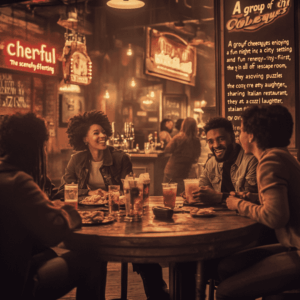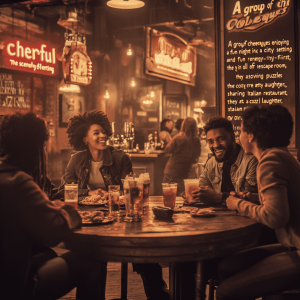Warmer
1. How long have you known your best friend? How did you meet?
2. Do you speak with anyone you went to school with?
3. Have you ever met an old friend? How did you react when you met them again?
Pre-listening Questions
Pre-listening quiz
Example Sentences
Listening
Comprehension Questions
- What percentage of people feel like no time has passed when they reconnect after a decade?
- Who are the two main people in the story, and how do they know each other?
- Why is Gloria’s marriage to Mark significant in their shared history?
- What does research say about the areas of the brain that are activated during reconnections?
- Who is Brenda, and how is she still connected to Gloria?
- What emotional situation involved Dan during high school?
- What percentage of high school reunion attendees feel anxious about past relationships?
- According to research, what factor makes people more likely to initiate reconnections?
- On average, how many meaningful contacts do people maintain, despite having many social media connections?
- What is “temporal bridging,” and how did Marissa and Gloria demonstrate it?
Answers
- 87% of people who reconnect after a decade report feeling like no time has passed.
- Marissa and Gloria were high school friends who reconnected after ten years apart.
- Gloria married Mark, their mutual high school friend, adding depth to their shared past.
- Reunions activate the same areas of the brain associated with reward and recognition, especially when seeing close family.
- Brenda is a mutual friend Gloria stayed in touch with, even when she cut ties with others.
- Dan had unresolved feelings for Gloria, but she was more interested in Mark.
- 65% of people feel anxious at reunions due to unresolved past relationships.
- People with confidence in their life choices are 40% more likely to reach out.
- Despite having around 338 social media contacts, most people maintain close relationships with only 15.
- “Temporal bridging” is the ability to connect past and present selves, and Marissa and Gloria showed it by immediately reconnecting and making future plans.
Vocabulary
Gap-Fill
Summarize
Imagine your partner is unfamiliar with the podcast you just listened to.
Tell them what the podcast is about in your own words.
Listen to the podcast again if needed.
Full Text
1. What if I told you that 87% of people who reconnect after a decade apart report feeling like no time has passed at all? The human brain has this remarkable ability to preserve social connections, even when they’ve been dormant for years.
That’s such a fascinating statistic. Does this have something to do with how our brains process long-term social relationships?
2. Well, it ties perfectly into this story I just came across about two former high school friends, Marissa and Gloria, reconnecting after ten years. What’s particularly interesting is how their conversation immediately picked up as if they’d never lost touch, despite all the life changes that happened in between.
Hmm… those kinds of reconnections must trigger something pretty powerful in our neural pathways, right?
3. Exactly. and research shows that these kinds of reunions actually activate the same areas of our brain associated with reward and recognition that light up when we see close family members. In this case, Gloria reveals she married their mutual high school friend Mark, which adds this fascinating layer to their shared history.
Oh wow, so it’s like their social circles never really dissolved, they just… transformed.
4. You know, that’s EXACTLY what makes this so interesting. Studies show that about 30% of high school friendships maintain some kind of connection through mutual friends, even when the original friends aren’t in direct contact. Like how Gloria mentions still talking to someone named Brenda, but specifically doesn’t maintain contact with others like Patricia, Kate, and notably, Dan.
Tell me more about how these relationship dynamics played out over the years.
5. Well, here’s where it gets complicated. There was this whole situation where Dan had feelings for Gloria, but she was interested in Mark. According to psychologists, these kinds of unresolved emotional tensions from our teenage years can actually influence our adult relationship patterns for decades.
The way these past experiences shape our present choices is really quite remarkable, isn’t it?
6. Absolutely fascinating. And get this — research indicates that about 65% of people who attend high school reunions report feeling anxious about unresolved past relationships. In this case, Gloria’s selective maintenance of certain friendships while deliberately avoiding others really exemplifies this pattern.
So what makes some people, like Marissa, actively seek out these reconnections while others maintain more distance?
6. That’s such a crucial question. Studies suggest it often comes down to personal growth trajectories. People who feel confident about their life choices are 40% more likely to initiate reconnections. What’s particularly interesting about Marissa’s approach is how she’s actively seeking these connections despite the challenges of modern communication.
Even with all our technology, meaningful connections still seem harder to maintain these days.
7. And here’s a surprising stat: despite having an average of 338 social media connections, most people only maintain meaningful contact with about 15 people. Yet when old friends do reconnect, like Marissa and Gloria, they often form deeper bonds than before because they’re meeting as fully formed adults.
The quality of those reconnections must vary significantly based on shared experiences and growth, don’t you think?
8. Well, research actually shows that shared experiences create an immediate foundation of trust. Like, 72% of people who reconnect after long periods report feeling more authentic in these relationships because there’s no need to explain their backstory — it’s already known.
That shared history really does create a unique kind of social connection, doesn’t it?
9. Exactly, and psychologists have found that these rekindled connections often serve as powerful mirrors for personal growth. When Marissa and Gloria quickly moved from catching up to making plans to meet, they demonstrated what researchers call “temporal bridging” — the ability to connect past and present selves seamlessly.
The way they navigate between their past and present identities must require some pretty sophisticated social skills.
10. You know, that’s where it gets really interesting. Studies show that successful reconnections often depend more on emotional intelligence than shared interests. About 83% of people report that understanding how they’ve grown and changed is more important than having things in common now.
These findings really do challenge our assumptions about maintaining relationships over time.
11. They absolutely do. And here’s what I find most compelling: research indicates that people who maintain or reconnect with old friendships show higher levels of life satisfaction and emotional resilience. It’s like these connections provide a kind of social anchor, helping us understand our own journey better.
So in essence, these reconnections aren’t just about nostalgia — they’re about creating something new from the foundation of shared history.
12. Precisely. And as we wrap up, I think that’s the key insight here: these reconnections aren’t about trying to recapture the past, but about using that shared history as a launching pad for new, more meaningful relationships. The story of Marissa and Gloria shows us that sometimes the best connections are the ones that get a second chance to grow.
Post-listening activity
Discussion Questions
Answer the questions
- Have you ever lost touch with someone you cared about? What caused the distance, and how did it feel?
- Can you think of a friendship or group you were once part of that eventually dissolved? Why do you think it happened?
- Who in your life exemplifies what it means to be a true friend? What do they do that makes them stand out?
- What does an authentic relationship look like to you? How can you tell when someone is being real with you?
- Can you describe a time when a conversation or connection flowed seamlessly? What made it feel so natural?
Speaking Activity 1
In groups of 3–4, students discuss:
A friendship they’ve lost touch with.
Why they think people reconnect.
What makes a reconnection successful or awkward.
Language Goal: Use vocabulary like reconnect, dissolve, authentic, emotional intelligence
Speaking Activity 2
Students interview each other:
What kind of person were you 10 years ago?
How have you changed?
What would an old friend be surprised to learn about you now?
Speaking Activity 3
Students role-play a surprise meet-up between two old friends who haven’t spoken in 10 years. They must:
Catch up on life events
Acknowledge past tension (optional)
Make plans for the future
Roles: Can assign characters (e.g., “You married your friend’s old crush”) for added drama.
Speaking Activity 4
Students pair up to record (or simulate) a short podcast episode where one interviews the other about a real or imaginary reconnection.
Prompt Ideas:
“Tell us about someone you reconnected with after years apart.”
“What makes a reconnection meaningful?”




